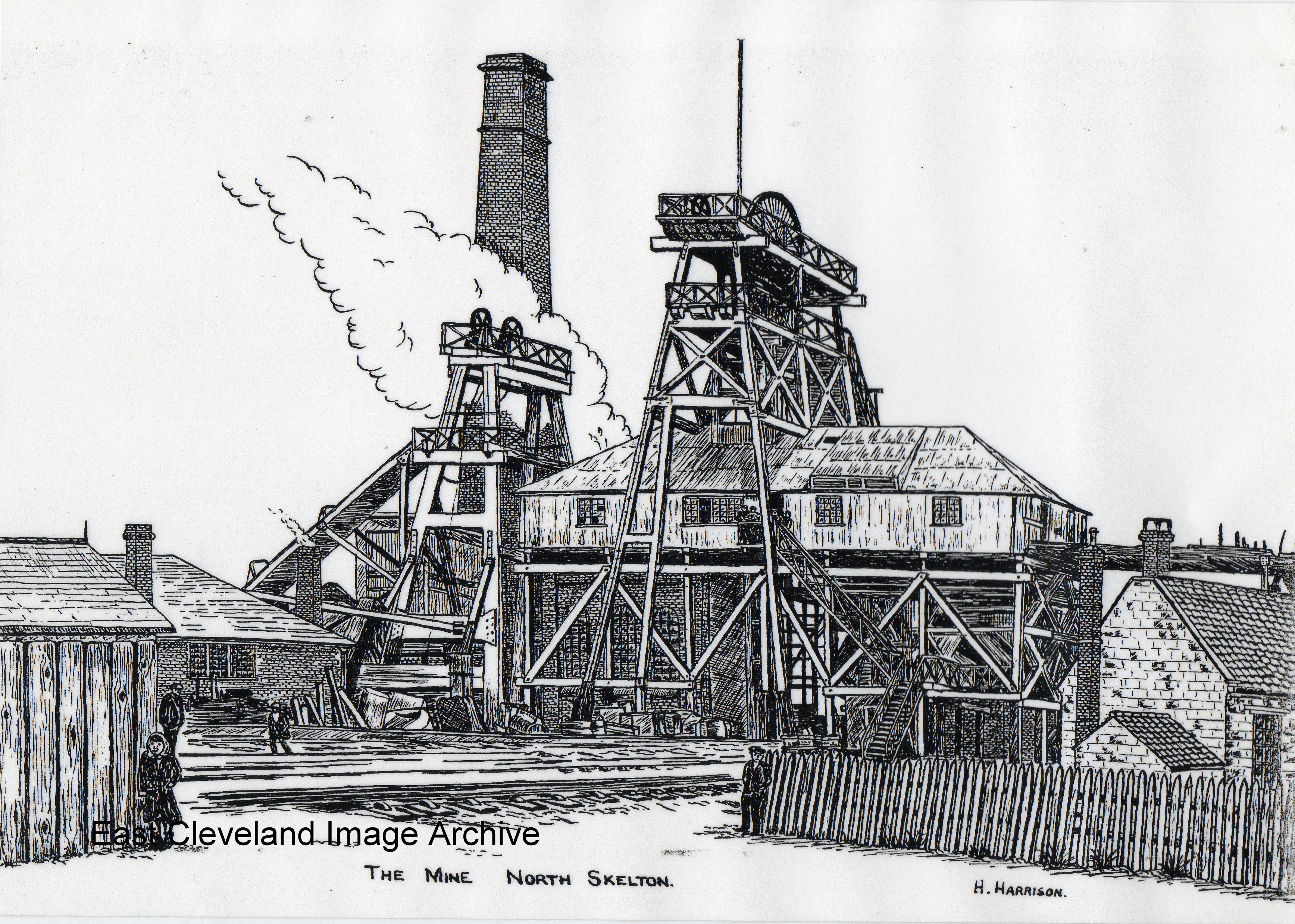
A wonderful line drawing of North Skelton mine by H. Harrison,
Image courtesy of Joan Webster.
|
|
||
 A wonderful line drawing of North Skelton mine by H. Harrison, 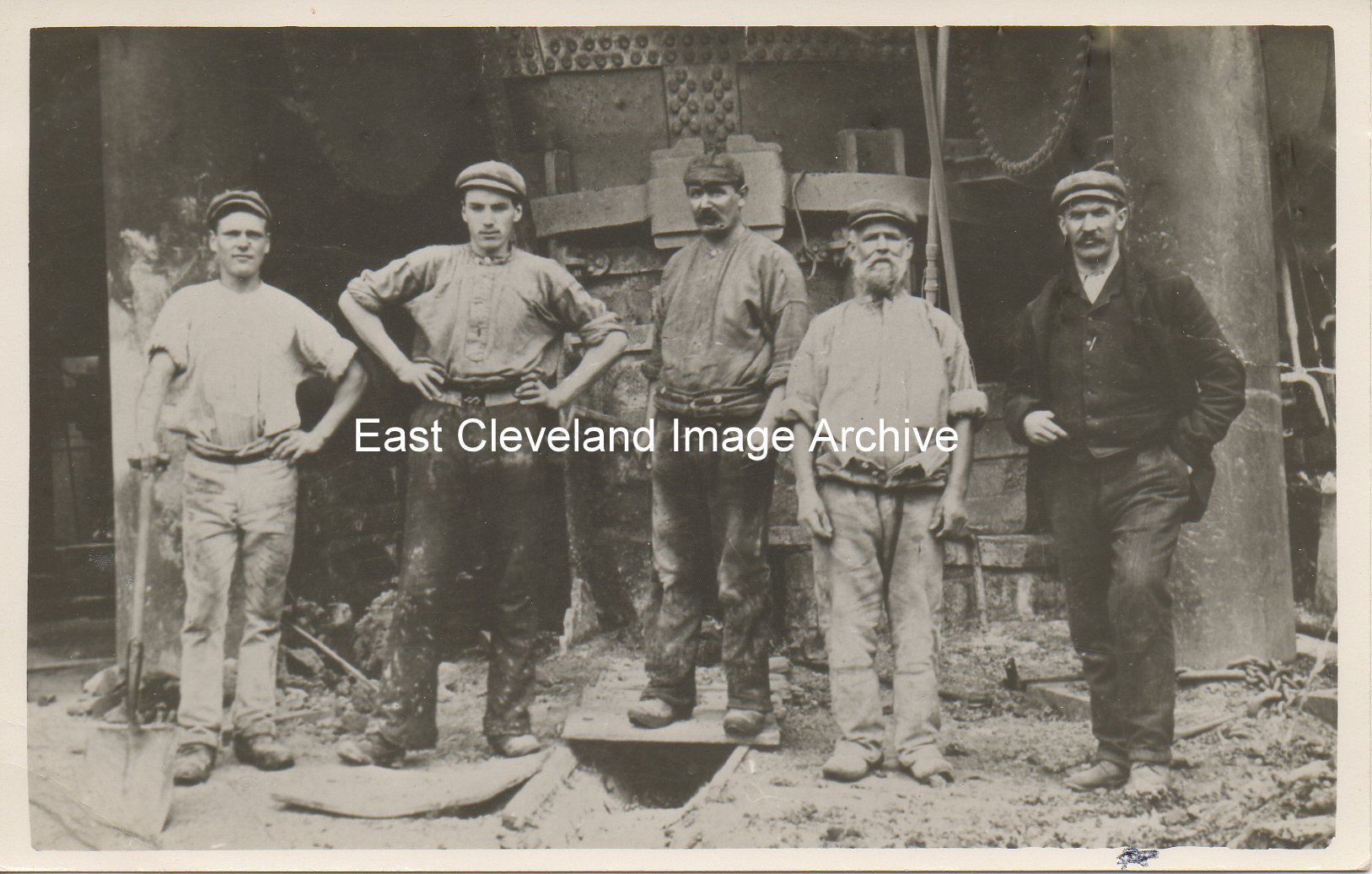 This looks like a ”Front Side Crew”; with iron furnace in the background and the gentleman in the centre seems to be standing over the sow channel for the molten iron. Far right hand side possibly foreman. Don’t think it’s No. 5 which was an altogether larger affair and tipped into ladles, not pig-beds, so it must be one of the earlier bank of 5 furnaces which have adorned quite a few postcards, but which furnace and why the occasion for a photograph? It couldn’t be a steel furnace, because Skinningrove furnaces were Siemens-Martin Basic Open Hearth furnaces and they all tilted back to tap (and forwards to tip slag). The problem is that there are the right number of men to crew a steel furnace (and that seems to be the progression from right to left, foreman (The gent on the right is wearing a fob watch which would suggest pre-1918), then 1st hand through to 4th hand – this one is a real enigma – anybody out there who can shed some light on the situation? Ann Robinson tells the Archive: “The man on the far right is my grandad William Atkinson.” Image courtesy of several sources, thanks to Ann Robinson for the update. 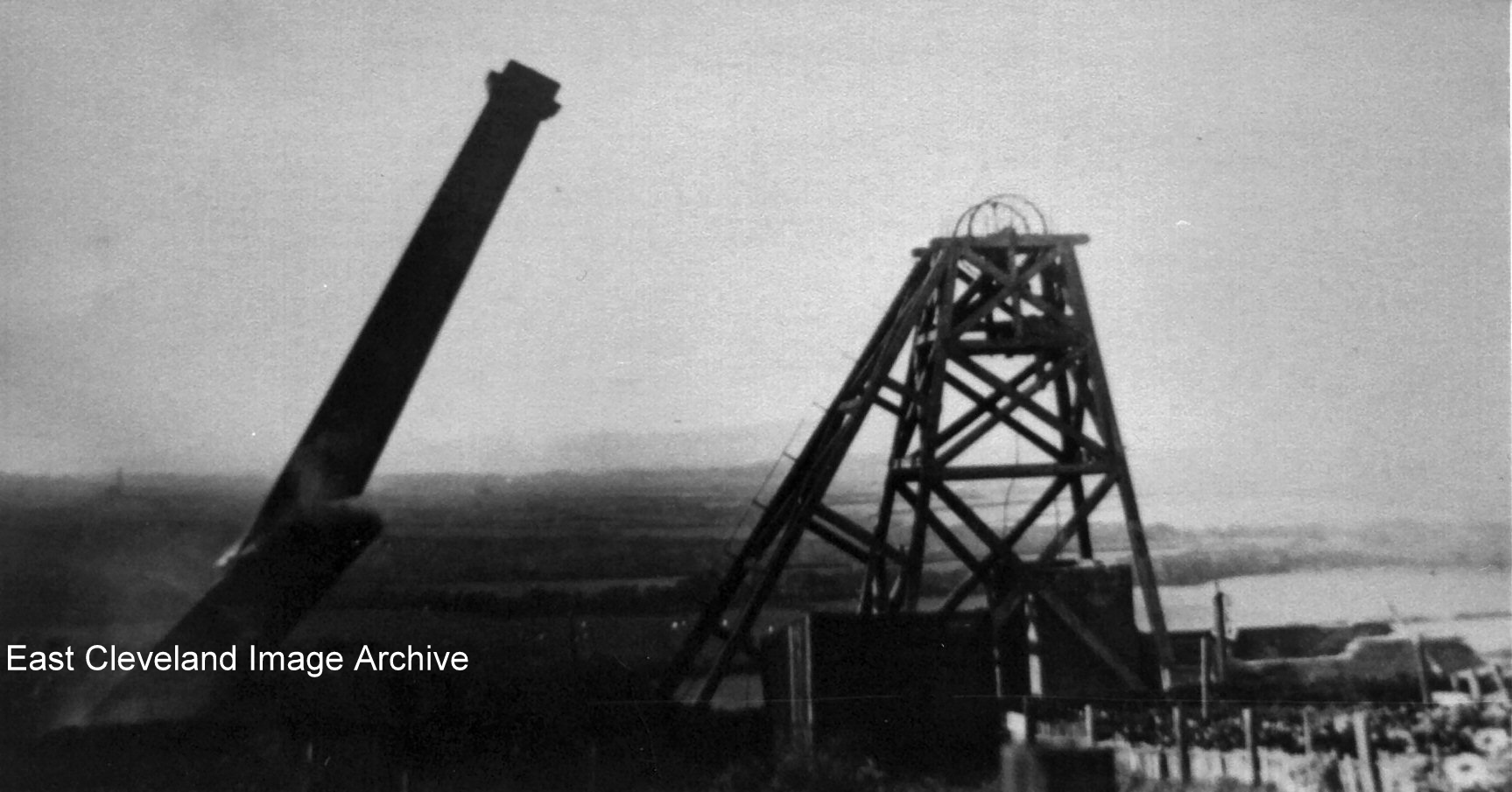 This one of a series of photographs which are now starting to appear of the dropping of the boiler house chimney, at Brotton Mine in 1921. Image courtesy of several sources, thanks to Simon Chapman for the dating information. 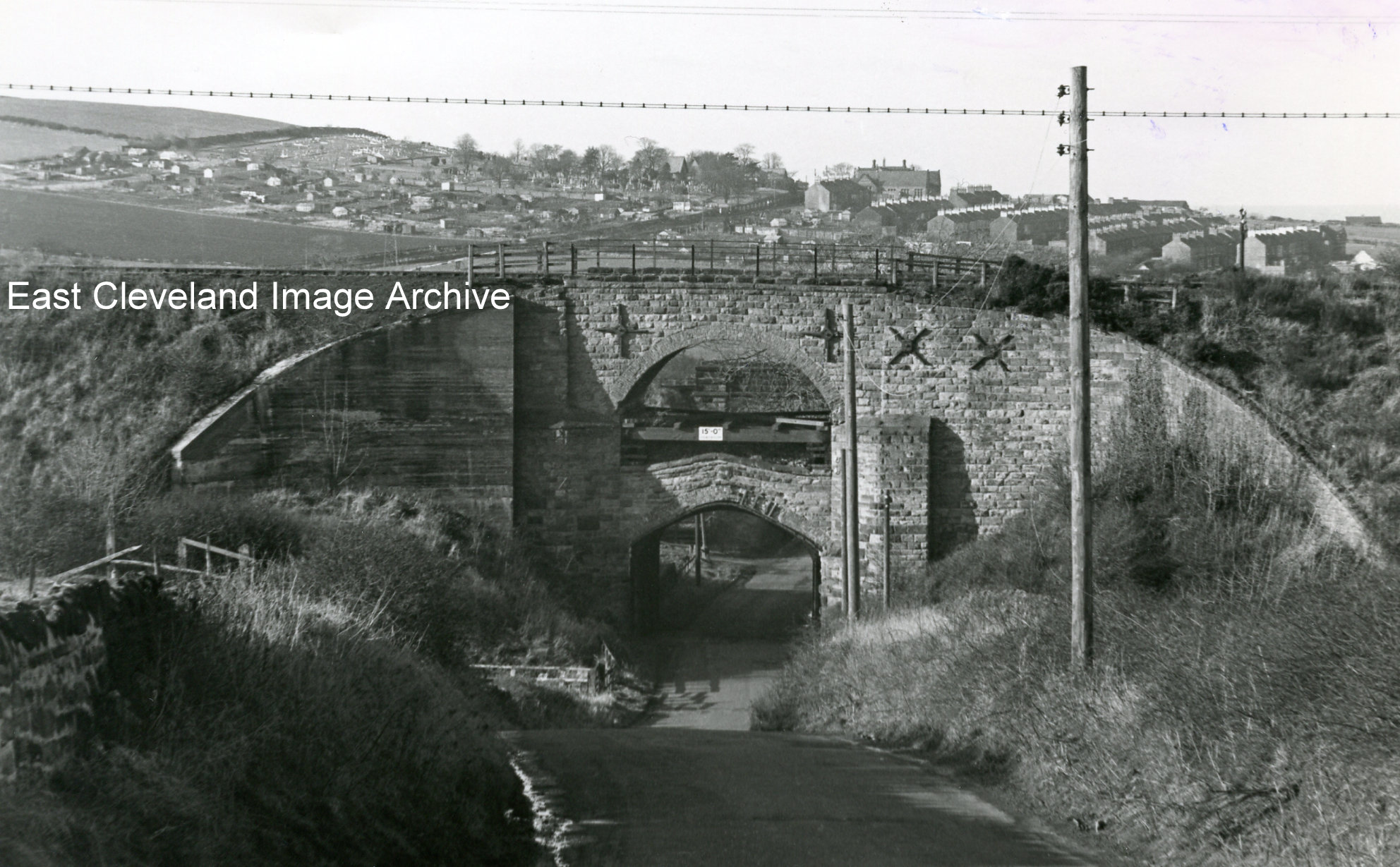 One of the two rail bridges at Claphow, Stanghow Road (the road connecting New Skelton directly to Lingdale). Due to mining subsidence the bridge was strengthen with the addition of a second arch inside the original arch. A buttress was added at the right hand side and four iron rods inserted through the parapet, whilst the left hand side was concreted. Andrew Pearson tells us: ”Really good photograph, looks to be from around 1964 or maybe early 1965. The railway was part of the much missed coastal route down to Whitby and Scarborough from Middlesbrough which closed completely in May 1958 between Loftus and Whitby West Cliff, passenger trains continued to run to Loftus until 1960 and then only to Guisborough until 1964 when it too closed under what came to be known as the Beeching Axe, which was to devastate the UK rail network. By this time the only traffic across this bridge was the weekly goods (mostly coal), to Boosbeck public delivery siding, from the Brotton direction, which ended in September 1964 when the depot at Saltburn took over coal deliveries enabling this line to be closed altogether. The line from Guisborough meantime had been cut just before reaching Boosbeck and was used for the storage of redundant wagons for the last five years of its life. During the summer of 1965 all the rails and fittings were uplifted from Brotton junction to the Esk Valley line junction near Nunthorpe inclusive, and this bridge was subsequently removed during improvements to the Lingdale to Skelton road. The other bridge behind it in the picture, on the Priestcroft Junction to Skelton triangle line, is still there.” Alastair MacKenzie adds: “I recall this too and think it was demolished in early 1970’s. Andrew is correct but doesn’t mention that the other leg of the triangle is still in use for the potash trains. This takes off at North Skelton and re-joins what would have been the triangle at Brotton. As a child living at Boosbeck, I recall seeing many iron-stone and passenger trains on this triangle. Often at night particularly if cold and frosty, the finished steel product trains to or from Skinningrove could be heard. The playing field behind our house at Wandhill, Boosbeck; looked onto the Boosbeck end of the triangle at Priestcroft. I never saw this personally but it is known that excursion trains from places like Leeds and Bradford, coming to Redcar and Saltburn, would run up to the triangle to be turned as the turntable at Saltburn was too small for loco’s like the V2. They would run up coupled in twos and threes to turn by reversing onto one or other leg.” Andrew Pearson confirms this: “The other leg of the triangle is part of the Saltburn – Boulby line which is very much still with us and in regular use but singled throughout, where before it was double track from Saltburn Junction through Brotton to Carlin How and then single track on through to Whitby/Scarborough with passing places at Loftus, Staithes, Hinderwell, Kettleness, Whitby West Cliff then Robin Hood’s Bay, Ravenscar, Staintondale and Cloughton. Opened in 1872(goods) and 1875(passenger) as the ‘Saltburn Extension’ the line served ironstone mines at Longacres, Lumpsey and Brotton in their time as well as Skinningrove Works now also Boulby Potash (rebuilt 1974 from Carlin How with a new viaduct) and it occasionally even sees steam hauled specials the most recent of which ran as far as Carlin How and back on March 30 2013. Intermediate stations were North Skelton and Brotton. Passenger services between Saltburn and Brotton ended September 6 1957 and between Loftus/Brotton/Guisborough April 30 1960 but goods services continued thereafter as in my previous post as well as mineral workings Lingdale Pit until 1962, Kilton (1963) and North Skelton (1964). Callum Duff asked: “I’m convinced that this bridge existed until around 1975 because I remember my Dad driving under it when I was a child and me being intrigued by such an unusual structure. Does anyone else know for sure when it was actually demolished?” Andrew responded with: “Not too sure as to the exact date but 1975 would be about right as it was definitely missing by 1976 when I happened to pass that way. As can be seen in the picture, the road was very much still a country lane and not suited to the ever increasing traffic even back in the 70s, never mind now when speeds are dangerously high so improvements were a priority on safety grounds. The bridge had been in a poor condition for a long time due to mining subsidence, it presented a bottleneck and once its rail function ended it would have had little further purpose.” Image courtesy of Ted Morgan (via Eric Johnson), with information from Eric Johnson; also thanks to Andrew Pearson, Callum Duff and Alastair MacKenzie for the updates. 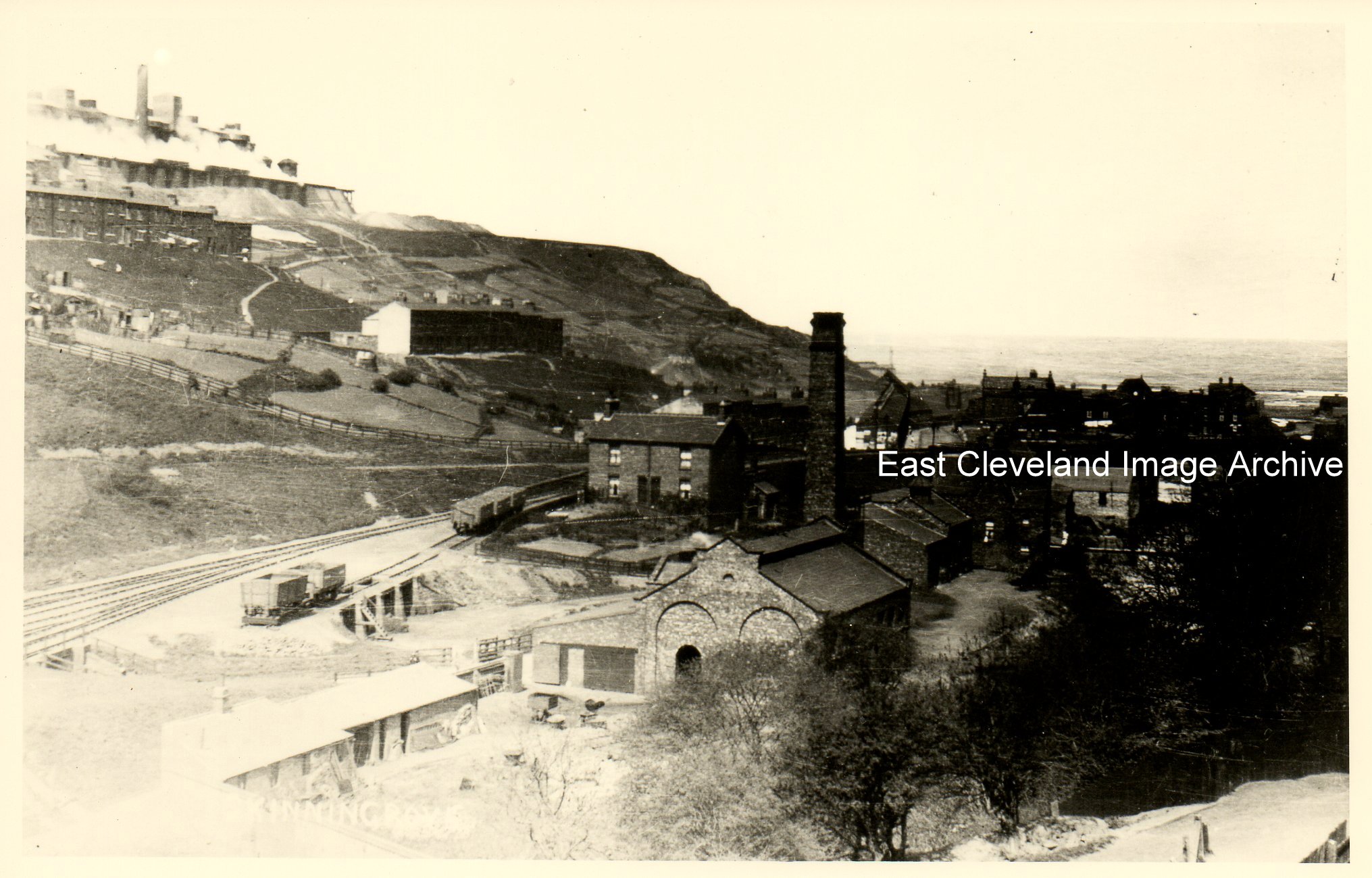 It’s a pretty poor title and time hasn’t been kind to the image either! Some nice architecture on display here, would that be the gas works in the foreground? Derick Pearson confirmed this fact, also advising: “If you look at the left side of the photograph you can just make out the tunnel that went under the railway. We used to walk under this on our way home from school. When it was wet weather it was often flooded. Traffic used to have to go through it in single file.” Image courtesy of the Pem Holliday Collection and others, thanks to Derick Pearson for that update. 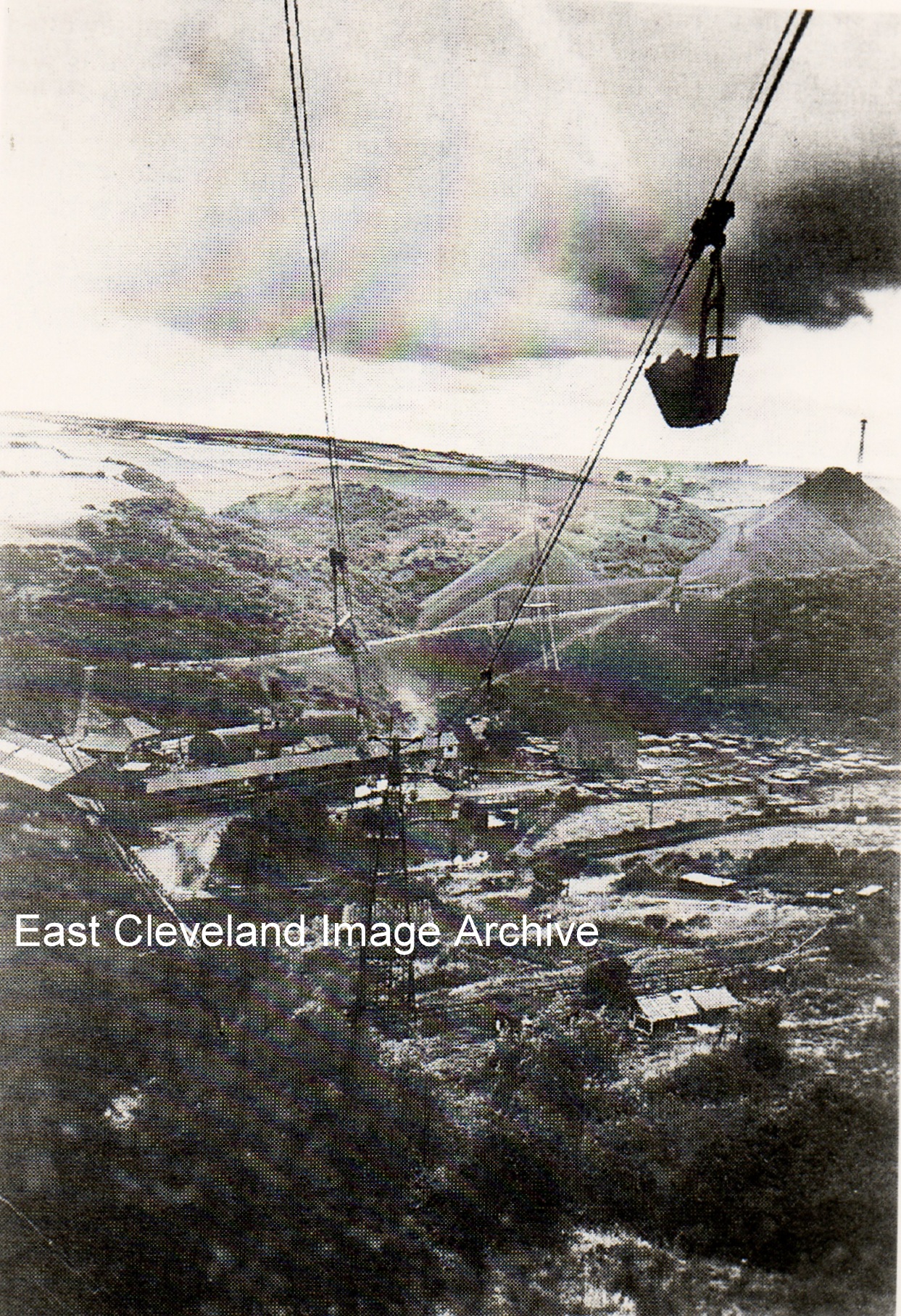 A working photograph of the aerial ropeway, locally known as ’the buckets’. We can see a full bucket of ironstone being taken up to the iron and steel works, with the mine in the distance at the bottom of the picture. Simon Chapman advised: “Loftus mines ironstone was transported up to Skinningrove Works from 1895 by connection into the abandoned workings of the North Loftus mine to avoid paying haulage charges to the N.E.R. By 1932 the North Loftus shaft steam winding equipment was thoroughly antiquated so the aerial ropeway was built to avoid using the shaft which was later filled in.” Image courtesy of the Pem Holliday Collection and others; thanks to Simon Chapman for information in the last paragraph. 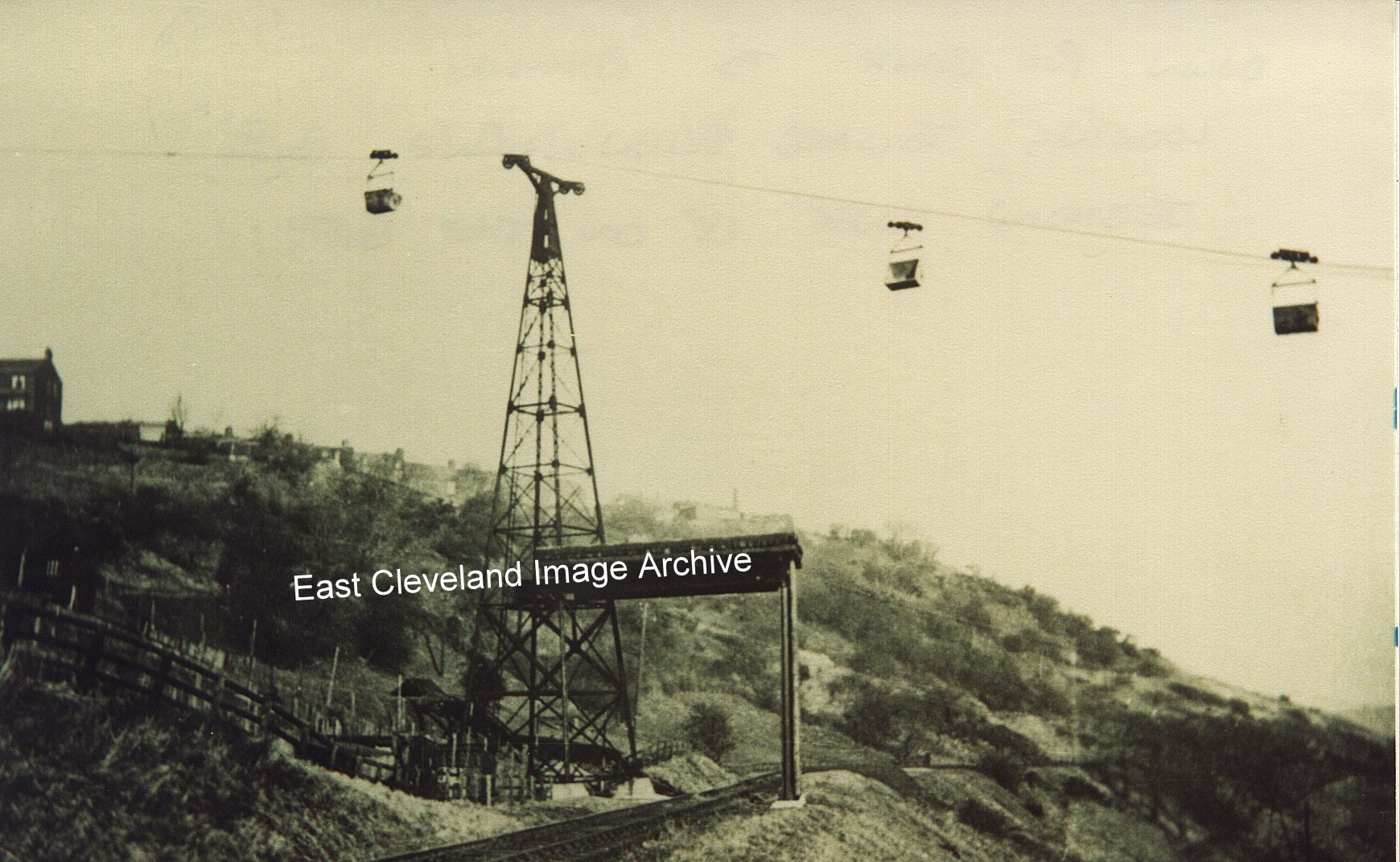 Loftus mines ironstone was transported originally transported from the Loftus (Skinningrove) mine up to Skinningrove Works via the zig-zag railway system along the valley side. From 1895 this transportation occurred via a connection into the abandoned workings of the North Loftus mine to avoid paying haulage charges to the N.E.R. By 1932 the North Loftus shaft steam winding equipment was thoroughly antiquated so the aerial ropeway was built to avoid using the shaft which was later filled in. An aerial ropeway (known locally as ”the buckets”) was constructed to take the stone from the valley floor up to Skinningrove Ironworks on the cliff top. This is the middle stanchion, the roofed structure over the zig-zag railway was to catch any falling stone jerked out of the buckets as a result of passing over the stanchion pulleys. This system was in use until local stone was superseded by cheaper foreign ores. (The topmost stanchion was still in place at the top gates of Skinningrove Iron and Steel Works when I worked there, adapted as a floodlight tower!). Image courtesy of the Pem Holliday Collection and others, thanks to Simon Chapman for the details of these changes in transportation. 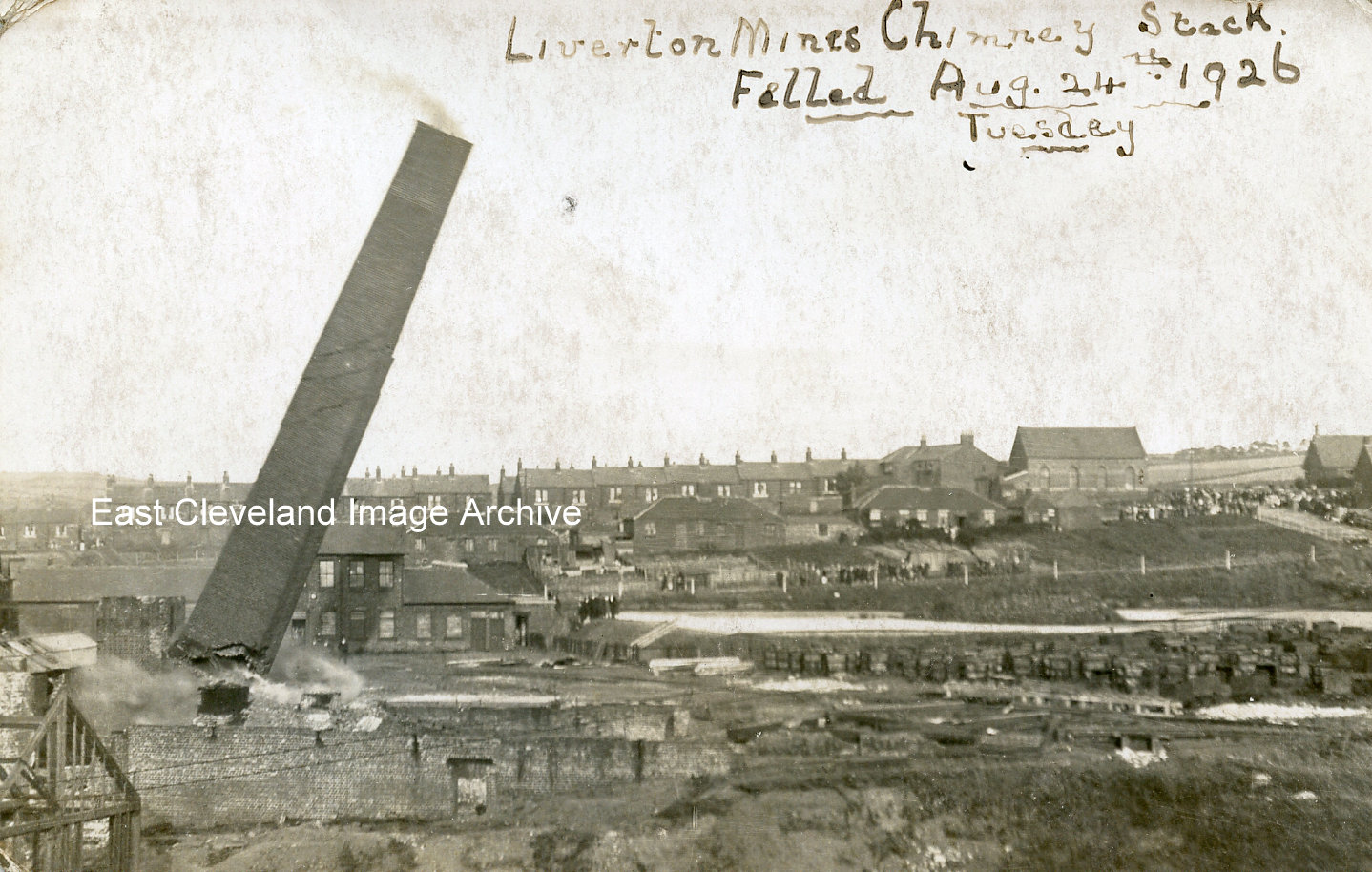 As the caption on the photograph says – Liverton Mines chimney stack felled on Tuesday 24th August 1926 – obviously a well attended event. Nowadays ‘elf and safety’ would have a field day!! Image courtesy of the David Linton Collection, the Pem Holliday Collection and others.
Sketch of one of the Zeppelin raids over Skinningrove Ironworks, these occurred in September 1915, April 1916 and possibly May 1916; it came to the Archive as a postcard. Does anyone know the origins of this sketch? Derick Pearson suggests that deeper examination of the image suggests that S. Grayson may have been the creator of this particular postcard, does anybody have any update on that. The Archive will research this possibility. Image courtesy of John Hannah, with information regarding Zeppelin raids from Zetland School (Loftus) logs; also thanks to Derick Pearson for his suggestion. 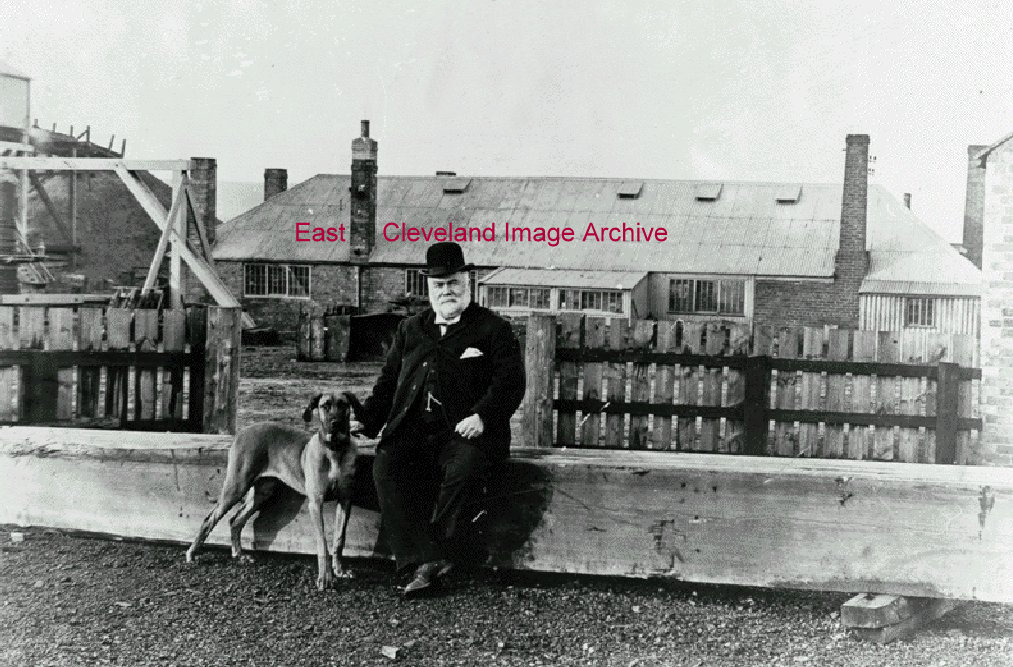 Nice dog with it’s owner, now known to be Thomas Ranson who was the Manager at North Skelton ironstone mine in the late 1800’s. Mr Ranson has often been wrongly identified as Mr Brown at North Skelton mine. The 1891 Census lists Thomas Ranson as Manager with his son Robert as a Deputy Overman, the whole Ranson family (ten in total) lived at numbers 1 and 2 Bolckow Street, North Skelton; by the 1901 and 1911 Census the family had moved to 1 Vaughan Street. Information courtesy of Eugenie Jarred. |
||
Recent Comments